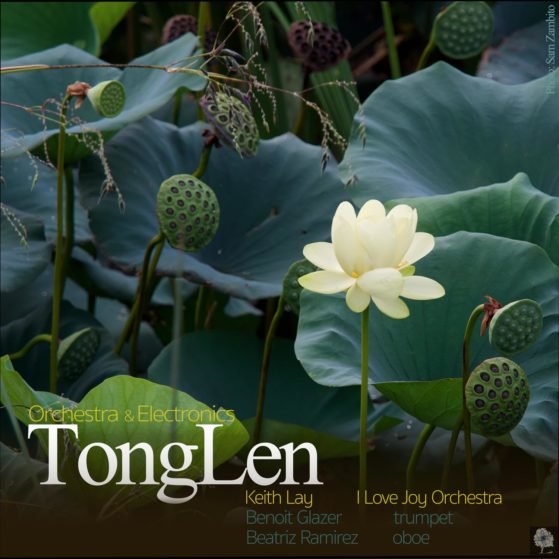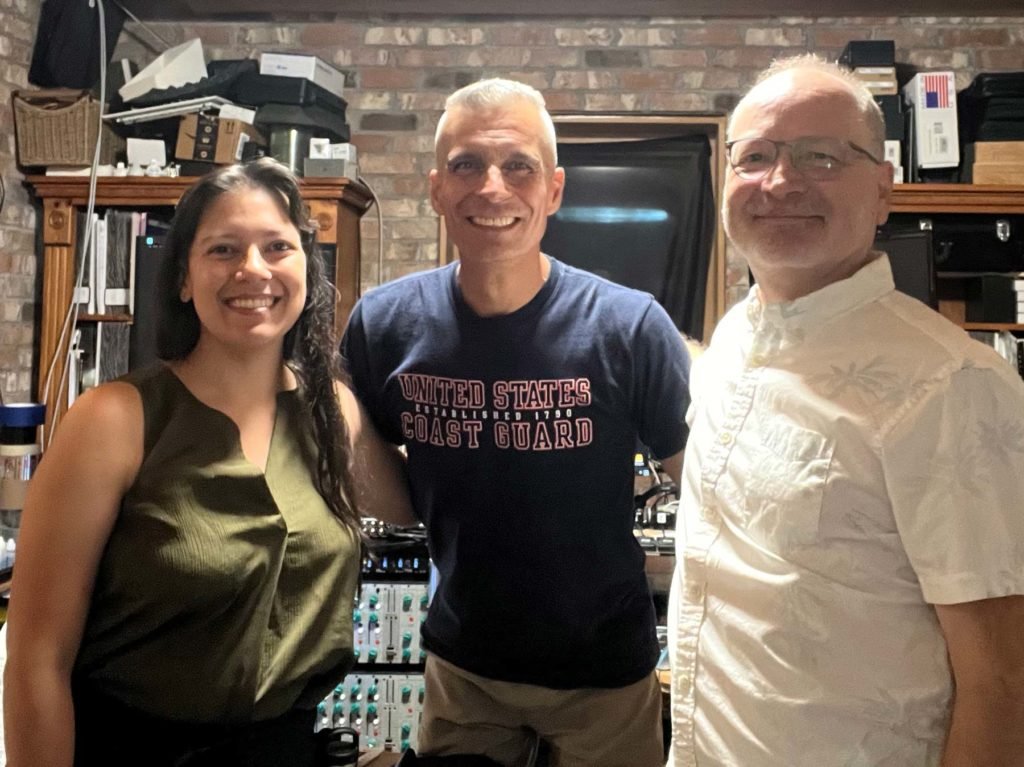This music, created with sampled orchestra and live musicians Beatriz Ramirez and Benoit Glazer, is formally structured to follow the experience of tonglen, a Tibetan Buddhist word translating to ‘give and receive.’ Tonglen is a series of mindful steps to build loving-kindness, empathy, and compassion for one, many, or any sentient beings in pain or suffering. It can also help us find room in our hearts to forgive those we hate, fear, dislike, or are prejudiced against. Tonglen is a technique for transforming difficulties into causes for a happier, more meaningful life. It unlocks doors of resistance within the practitioner and invites connection to those suffering. Learn how to do tonglen at “What is Tonglen Meditation?” on A Skeptic’s Path To Enlightenment’s website.
Featuring
BEATRIZ RAMIREZ Oboe
BENOIT GLAZER, Trumpet
with the I LOVE JOY ORCHESTRA


production notes
This production represents a new direction for me: producing rich, sonorous musical experiences to be released for streaming as immersive and HD playback in addition to any concerts it may receive. TongLen expands the orchestra to include electronic instruments that will enhance the emotion and story of the music through playback technology.
Special thanks are owed to this production’s fine soloists! Beatriz Ramirez, oboe, sumptously rendered the primary melody, recorded as a separate track at the Timucua Arts Foundation‘s main room” by Benoit Glazer. Benoit also tracked his own gorgeous playing of the 1st trumpet passages, including solos with Beatriz.
This is the first non-commercial composition that I’ve released that wasn’t real orchestral musicians. I took advantage, best I could, of my sample libraries and added live tracks of important oboe and trumpet in the excellent acoustics of the Timucua Arts main room.
The production began as an adaptation of a piece for the small, community Stow Orchestra that was premiered a few years earlier. I loved its simple melodies, rich harmony and peaceful pace. Convinced that our concert world could use more calm and relaxing music, and excited to see if I could create a believeable atmost production on a small budget, I decided to further expand the piece with electronics in order to better capture the extreme emotions of Tonglen. Unfortunately, the tech was not quite ready (maybe I wasn’t ready for the tech, too). Beginning with the original notated score in Sibelius, I replayed most tracks into Logic Pro instead of exporting them via MIDI to gain more expressive lines. Some CC# automation was drawn in by mouse instrument by instrument, too. But, mixing became over-complicated because of computer internal buss mis-agreements between my 5.1 samples and live tracks with Beatriz and Benoit – forcing many compromises. I want to revisit this project for a re-do!
Flutes, Oboe 2, Clarinets, Bassoons: Vienna Symphonic SYNCHRON-ized Woodwinds
Horns, Trumpet 2, Trombones: Vienna Symphonic Synchron Brass
Timpani, Percussion: Synchron Percussion I
Piano: Synchron Yamaha CFX
Sub Sine-waves: Omnisphere 2
Tuned gongs: 8dio
Crowd: self sampled
Strings: Synchron Strings Pro
Benoit Glazer and Beatriz Ramirez were both recorded by Benoit at the gorgeous Timucua Arts Foundation’s main concert room.
Reverb: MIR Pro 3D
Understanding The Piece
Tonglen is practiced anyplace or anytime, but I placed this symbolic journey in a silent meditation hall, starting and ending with a C bell (chime). As in meditation, the long, slow dying out of the bell into silence invites our full attention and focus. Winds imitate the bell, while a single violinist plays a quiet high harmonic on G.
The Practice
We arrive at mindfulness: a state of being in maximum awareness where thoughts and other mental activities relax away revealing sensory inputs, body feelings, and emotions. This non-verbal, non-thinking state fills each moment.
The music
Musically, mindfulness is a gesture having two parts: an empty sound of a perfect 4th interval in the strings followed by that being filled in with a warm diatonic cluster of many pitches, led by a two-note call of a falling minor 3rd: the oldest and most universal musical motif. The falling m3rd seems built into the human genome because it is used by every family on Earth when calling for a member to come home. The mindfulness gesture sometimes appears as just a solo instrument playing the minor third fall, sometimes with the string harmonies, and sometimes just the strings.
The Practice
Mindfulness is the bed from which we grow the flower blossom of tonglen, the seed simply being our intention to do so.
the Music
Out of the mindfulness music grows a pentatonic melody, beautifully rendered by Beatriz’s oboe and the flute. This melody represents our intention to open ourselves to receive and give.
The Practice
To walk in anothers’ shoes, and feel their pain, is a precursor to understanding them, which opens our hearts to loving-kindness. Our intention to understand must be strong enough to walk an arduous path of listening for the others’ experience: one that may go unexpected places we’ve never been. Sitting with anothers’ pain without judgement of them is crucial. We may experience deep heartbreak, terror, trauma, loneliness – whatever brought them to their suffering.
The Music
To musically portray not knowing where the process might lead, I continuously disrupt the rhythmic flow using my ‘flowing meter’ technique. The tempo accelerates and decelerates, building tension – then releases it just to build up again, release a little higher, and build up again. Each flowing meter cycle of accelerando to ritardando is fashioned in the ratio of the golden mean (1.618:1), giving it a natural and organic pace of change.
To impart a dangerous emotional storm, I use a synthesizer (Omnisphere) to create massive low frequencies (a common technique used in film sound) an octave or two below the instruments playing the bass line. Beginning at B0 (30Hz), NOTE: MOST speaker systems will be unable to reproduce this. These sub-frequency notes are not available in the natural orchestra (at a sufficient level), and I see no reason not to use modern tools to bring them to the concert experience.
On the second flowing meter phrase, I used a strange noise to quietly emerge from the rear speakers to elicit fear (for those able to listen to the atmos® surround-sound playback version). The sound reminds me of the angry flocks in Alfred Hitchcock’s The Birds. In the following phrase, a downward scale of a strange bell from the rear speakers creates a feeling of confusion as a result of incoherency. Since we humans are accustomed to facing objects to which we are listening, sounds coming from behind our head imply they come from our inner hearing – or subconscience. (atmos® version only)
In answer to the upheaval, a trumpet solo calmly settles the flowing meter into a regular tempo and restates our intention to feel and understand. The solo oboe and flute join the restatement. Mindfulness musical elements support them.
After the trumpet solo, the deep emotional dive into pain returns, this time with larger orchestral forces. The sounds of a crowd of people appear from behind. The piano repeats diatonic clusters, with the top note being an explicit inversion of mindfulness – continually stepping upward as the entire orchestra lifts its tremendous weight through repeating and lifting phrases, each speeding up and slowing down, up and up, creating immense tension and slowly transforming into joy.
At the peak of the climb, the brass and strings gloriously complete the transformation with a jubilant statement, almost a fanfare.
The Practice
Tonglen transmutes dark smoke into light, lead into gold. Compassion and empathy allow us to breath the pain into our bodies. When it touches our hearts, dark matter explodes into brilliant light.
Tonglen is a technique that fosters compassion and loving-kindness within us. It does not necessarily create joy as it does in this music.
The Music
Alloying the primary elements of the music of pain with the pentatonic melodies of mindfulness and intention, a new music is formed. Sounds, once essential elements in the past, now recombine in a new key area of Eb with a new melody in the brass. A softer, flowing section arrives sharing the elements and theme of intention, which, is driven to ecstatic heights with flowing meter. Finally releasing an explosion of color and sound at the final climax, the new music and new key funnel down into a quiet, single pitch C, from where we began.
Mindfulness returns in the strings. The melody of intention returns, this time with oboe, trumpet, flute and the 1st Violins in unison. The bell ends the meditation experience, fading into silence.
The original version of “TongLen” was titled “Joy of Mindfulness,” composed in the winter of 2014 for Darrell Music’s Stow Symphony (a community orchestra in N. Ohio) and premiered in the Summer of 2015.
It was scored for:
- 2Flutes
- 2 Oboes
- 2 Clarinets in Bb
- 2 Bassoons
- 2 F Horns
- 2 Trumpets
- 2 Trombones
- Timpani
- 2 percussionists
- Bass Drum
- C4 Chime
- Crash Cymbals
- Triangle
- Piano
- Strings
Very few changes were made to the score of “The Joy of Mindfulness” to the 2022 “TongLen” revision, but four electronic instruments were added:
- “Sub Bass”: Apple Sculpture
- “Choral FX Men Warmup Rev”: Omnisphere 2
- 8Dio Caisa Drum through NI Kontakt 5
- The crowd sample was taken from a recording made at Timucua Arts

